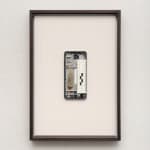Nicolás Lamas
Fluid past, 2024
Dismanteled cellphone, Paleolithic tool and photo scale
30 x 43 x 3 cm
11 3/4 x 16 7/8 x 1 1/8 inches
11 3/4 x 16 7/8 x 1 1/8 inches
Copyright The Artist
Photo: Marjorie Brunet Plaza
Weitere Abbildungen
In „Fluid Past“ (2024) bringt Nicolás Lamas Fragmente eines iPhones mit einem prähistorischen Steinwerkzeug und einer Fotografie in einen gemeinsamen Rahmen – eine Begegnung von Zeitschichten, die sich in Material...
In „Fluid Past“ (2024) bringt Nicolás Lamas Fragmente eines iPhones mit einem prähistorischen Steinwerkzeug und einer Fotografie in einen gemeinsamen Rahmen – eine Begegnung von Zeitschichten, die sich in Material und Bedeutung überlagern. Beide sind Ausdruck menschlicher Gestaltung, Verlängerung der Hand, Werkzeuge der Weltaneignung. Lamas inszeniert die Ablösung von Technologien nicht als Fortschritt, sondern als Verschiebung von Form und Bedeutung. Die Bauteile des Mobiltelefons, einst Träger digitaler Kommunikation, liegen offen und entladen, während das steinerne Werkzeug seine funktionale Klarheit behält. Zwischen ihnen entfaltet sich ein Raum der Reibung, indem verhandelt wird was bleibt, wenn Funktion verschwindet und was überdauert, wenn Technologie sich ablösen. Diese Version hebt hervor, dass der Wandel zwischen den Objekten nicht als starrer Fortschritt, sondern als dynamische, fließende Veränderung verstanden wird. Die „Fluidität“ verweist auf den kontinuierlichen, nicht geradlinigen Wandel der technologischen und kulturellen Bedeutungen.
In “Fluid Past” (2024), Nicolás Lamas brings together fragments of an iPhone with a prehistoric stone tool and a photograph within a single frame—a meeting of temporal layers that overlap in both material and meaning. Both objects express human creativity, extensions of the hand, tools for engaging with the world. Lamas stages the displacement of technologies not as progress, but as a shift in form and meaning. The components of the mobile phone—once carriers of digital communication—are laid bare and discharged, while the stone tool retains its functional clarity. Between them, a space of friction unfolds, where it is negotiated what remains when function disappears, and what endures when technology recedes. This version emphasizes that the transition between objects should not be understood as rigid progress, but as dynamic, fluid transformation. The term “fluidity” points to the ongoing, non-linear change in technological and cultural meanings.
In “Fluid Past” (2024), Nicolás Lamas brings together fragments of an iPhone with a prehistoric stone tool and a photograph within a single frame—a meeting of temporal layers that overlap in both material and meaning. Both objects express human creativity, extensions of the hand, tools for engaging with the world. Lamas stages the displacement of technologies not as progress, but as a shift in form and meaning. The components of the mobile phone—once carriers of digital communication—are laid bare and discharged, while the stone tool retains its functional clarity. Between them, a space of friction unfolds, where it is negotiated what remains when function disappears, and what endures when technology recedes. This version emphasizes that the transition between objects should not be understood as rigid progress, but as dynamic, fluid transformation. The term “fluidity” points to the ongoing, non-linear change in technological and cultural meanings.



